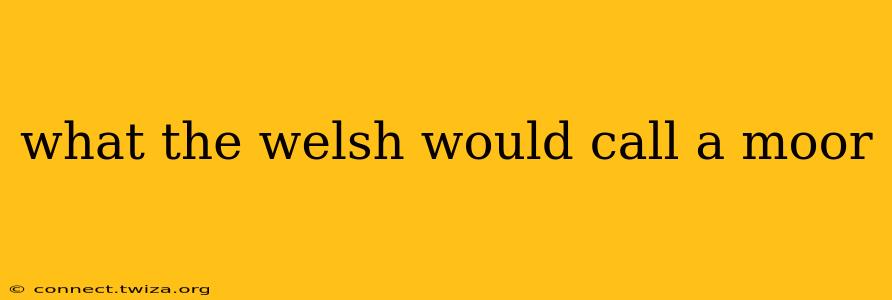What the Welsh Would Call a Moor: Exploring the Diverse Landscapes of Wales
The term "moor" evokes images of expansive, windswept landscapes, often characterized by peat bogs, heather, and low-lying shrubs. While the English language uses "moor" quite broadly, the Welsh language offers a richer, more nuanced vocabulary to describe these varied environments, reflecting the unique geography and cultural relationship the Welsh people have with their land. There isn't one single, perfect translation for "moor" in Welsh, as the specific term depends heavily on the characteristics of the land in question.
Let's delve into some Welsh terms and explore how they relate to different types of moorland:
1. What are the different types of moorland in Wales?
Wales boasts a diversity of moorland habitats, each with its own distinct features. These include:
- High-altitude moorland: Found on mountain ranges like Snowdonia and the Brecon Beacons, these areas are characterized by harsh weather conditions, sparse vegetation, and often rocky terrain.
- Lowland moorland: These moors are found at lower elevations and may be wetter, with more extensive peat bogs and a greater variety of plant life.
- Coastal moorland: Found near the coast, these areas are influenced by sea winds and often exhibit a unique blend of moorland and coastal flora.
These variations influence the choice of Welsh word used to describe them.
2. What Welsh words are used to describe moorland?
Several Welsh words can be used, depending on the context:
-
Mynydd (mountain): While not directly translating to "moor," mynydd is often used to describe upland areas, including those with moorland characteristics. If the moorland is located on a mountain or hill, mynydd might be the most appropriate term.
-
Cors (bog or marsh): This term is used for wetter, boggier areas of moorland, highlighting the presence of peat and standing water. A cors is typically a wetter, less grassy type of moorland.
-
Gors (moor or bog): This is probably the closest single translation to "moor," but it can also refer specifically to a type of peat bog. The distinction between cors and gors can sometimes be subtle, depending on regional dialects and the specific characteristics of the land.
-
Gwlybdir (wetland): A more general term encompassing various types of wet habitats, including moorland. This term is useful when the specific type of moorland isn't crucial to the description.
The choice of word depends heavily on the specific characteristics of the moorland being described. A high-altitude, rocky area might be called a mynydd, while a low-lying, boggy area would be more appropriately referred to as a cors or gors.
3. Are there regional variations in the terminology?
Yes, as with any language, regional variations exist in the way people describe moorland in Welsh. Specific dialects might favor one term over another, or employ additional, localized terms not widely used elsewhere.
4. How do these terms reflect the Welsh relationship with the land?
The varied vocabulary used to describe moorland reflects the deep connection between the Welsh people and their environment. The nuanced descriptions are not just about geography; they capture the cultural significance of these landscapes, which have shaped Welsh history, traditions, and identity.
In conclusion, there isn't a single Welsh equivalent for the English word "moor." The appropriate term depends on the specific characteristics of the landscape, regional variations in language, and the subtle nuances of meaning embedded within Welsh words. Understanding this linguistic diversity offers valuable insight into the rich tapestry of Welsh culture and its intimate relationship with the land.
